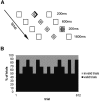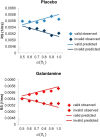Cholinergic stimulation enhances Bayesian belief updating in the deployment of spatial attention
- PMID: 25411501
- PMCID: PMC4236403
- DOI: 10.1523/JNEUROSCI.0091-14.2014
Cholinergic stimulation enhances Bayesian belief updating in the deployment of spatial attention
Abstract
The exact mechanisms whereby the cholinergic neurotransmitter system contributes to attentional processing remain poorly understood. Here, we applied computational modeling to psychophysical data (obtained from a spatial attention task) under a psychopharmacological challenge with the cholinesterase inhibitor galantamine (Reminyl). This allowed us to characterize the cholinergic modulation of selective attention formally, in terms of hierarchical Bayesian inference. In a placebo-controlled, within-subject, crossover design, 16 healthy human subjects performed a modified version of Posner's location-cueing task in which the proportion of validly and invalidly cued targets (percentage of cue validity, % CV) changed over time. Saccadic response speeds were used to estimate the parameters of a hierarchical Bayesian model to test whether cholinergic stimulation affected the trial-wise updating of probabilistic beliefs that underlie the allocation of attention or whether galantamine changed the mapping from those beliefs to subsequent eye movements. Behaviorally, galantamine led to a greater influence of probabilistic context (% CV) on response speed than placebo. Crucially, computational modeling suggested this effect was due to an increase in the rate of belief updating about cue validity (as opposed to the increased sensitivity of behavioral responses to those beliefs). We discuss these findings with respect to cholinergic effects on hierarchical cortical processing and in relation to the encoding of expected uncertainty or precision.
Keywords: Bayesian inference; acetylcholine; saccades; spatial attention.
Copyright © 2014 the authors 0270-6474/14/3415735-08$15.00/0.
Figures





References
-
- Bond A, Lader M. The use of analogue scales in rating subjective feelings. Br J Clin Pharmacol. 1974;47:211–218. doi: 10.1111/j.2044-8341.1974.tb02285.x. - DOI
Publication types
MeSH terms
Substances
Grants and funding
LinkOut - more resources
Full Text Sources
Other Literature Sources
